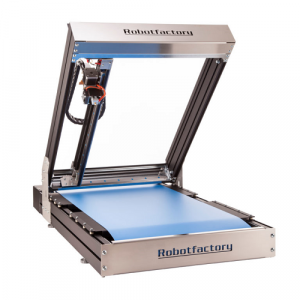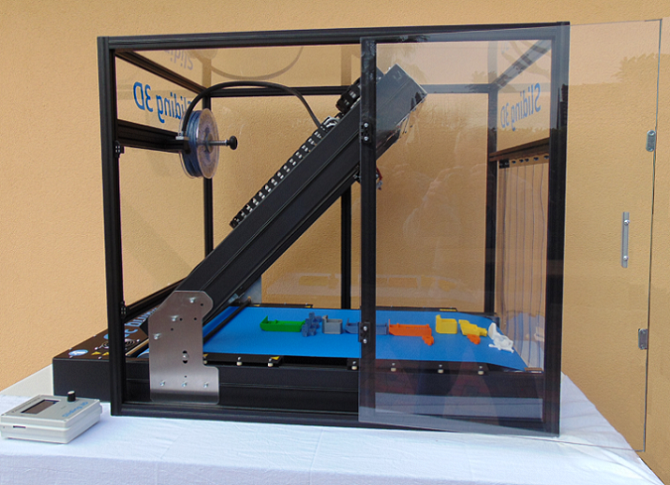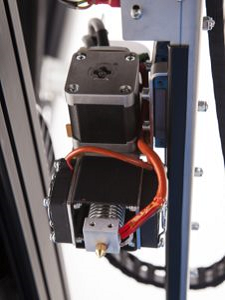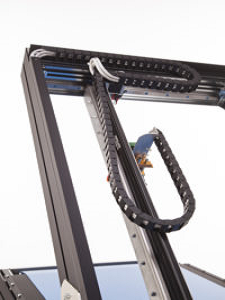Later this week at Maker Faire Rome, Italy-based Robot Factory will be presenting its new Sliding-3D system, which uses a conveyor belt as an essentially limitless build platform. The company is only the latest to take the plunge with this innovative type of 3D printer, which has been gaining in popularity over the last few years thanks to its ability to 3D print long parts with the help of the conveyor belt feature.
Two years ago, Robot Factory began developing the Sliding-3D for the purposes of lowering post-processing time, plastic 3D printing waste, energy consumption, and costs. The Sliding-3D is an effective way for companies to achieve more sustainable manufacturing processes.
 This new desktop 3D printer, which uses thermoplastic material extrusion, makes it possible to 3D print, uninterrupted, very long objects, due to an infinite build platform and a 45° extruder. The Sliding-3D can simplify small series production, allows for the creation of functional prototypes, and helps companies reorganize their production processes.
This new desktop 3D printer, which uses thermoplastic material extrusion, makes it possible to 3D print, uninterrupted, very long objects, due to an infinite build platform and a 45° extruder. The Sliding-3D can simplify small series production, allows for the creation of functional prototypes, and helps companies reorganize their production processes.
The Sliding-3D exploits this moving platform, along with the translational function and inclination of the layers, to decrease up to 100% of the supports for overhangs that are normally required – saving material and money and reducing post-processing times. Its 410 x 380 mm x ∞ (endless) build volume means that the Sliding-3D can achieve an uninterrupted work cycle.
While other large-dimension 3D printers do exist, a human operator typically needs to be present in order to remove completed parts and prepare for additional print jobs. The Sliding-3D’s conveyor belt negates this – whenever a print is completed, another job will begin and 3D printing can continue, without needing an operator to take care of anything. The belt moves forward until the completed print rolls off and into a collection basket underneath the 3D printer’s front roller.
“So Sliding‐3D can be used as a sort of “desktop factory”, since objects can be printed “continuously”, thus allowing a “mass” production,” Robot Factory wrote in a post on its website.
Previous production processes were long and expensive, but have started to become faster in recent years, thanks in large part to 3D printing, which also offers the possibility of customization and increased time to market. Companies are focused on lowering development time and overcoming traditional design limitations, as well as making prototypes which are “faithful to the final product” in order to allow faster economic testing.
“Despite the appetite for change, many companies have not realized the full value of some of the new technologies,” Robot Factory wrote. “There is little confidence in the quality obtainable, also because many times the initial approach is oriented towards so‐called ‘consumer’ products at low cost, when instead a relatively more important investment for a product aimed at a professional use of 3D printing can change significantly the result!”
 Robot Factory’s goal with the Sliding-3D was the continuous, rapid production of 3D printed objects that are ready to use. This new 3D printer is a valuable tool, as it supports companies in both the development and production processes. The Sliding-3D also wastes less material due to its lack of supports, which also helps reduce print time and energy consumption well.
Robot Factory’s goal with the Sliding-3D was the continuous, rapid production of 3D printed objects that are ready to use. This new 3D printer is a valuable tool, as it supports companies in both the development and production processes. The Sliding-3D also wastes less material due to its lack of supports, which also helps reduce print time and energy consumption well.
Speaking of sustainability, the materials tested and used with the Sliding-3D are mainly biodegradable plastics, like PETG and PLA.
“The confidence in the results is one of the decisive elements in the choice of a new technology and we of Robot Factory that we always direct our choices towards the creation of innovative products engineered with the utmost attention to detail, we designed Sliding‐3D with particular attention to the mechanical precision and the rigidity of the system, to guarantee high precision in the printing result and an unmatched surface finish (compared with other printers that use the same plastic extrusion technology),” Robot Factory concluded.
If you will be attending Maker Faire Rome later this week, you’ll have a chance to see Robot Factory’s new Sliding-3D system for yourself. If you’re like me and lack the necessary funds or time to travel to Italy, take a look at the video below to see the Sliding-3D’s conveyor belt in action:
What do you think about this new 3D printer? Discuss this story and other 3D printing topics at 3DPrintBoard.com or share your thoughts in the Facebook comments below.
Subscribe to Our Email Newsletter
Stay up-to-date on all the latest news from the 3D printing industry and receive information and offers from third party vendors.
Print Services
Upload your 3D Models and get them printed quickly and efficiently.
You May Also Like
3D Printing News Briefs, July 2, 2025: Copper Alloys, Defense Manufacturing, & More
We’re starting off with metals in today’s 3D Printing News Briefs, as Farsoon has unveiled a large-scale AM solution for copper alloys, and Meltio used its wire-laser metal solution to...
3DPOD 260: John Hart on VulcanForms, MIT, Desktop Metal and More
John Hart is a Professor at MIT; he´s also the director of the Laboratory for Manufacturing and Productivity as well as the director of the Center for Advanced Production Technologies....
3D Printing News Briefs, June 28, 2025: Defense Accelerator, Surgical Models, & More
In this weekend’s 3D Printing News Briefs, 3YOURMIND was selected to join an EU Defense Accelerator, and PTC has announced model-based definition (MBD) capabilities within Onshape. Finally, a study out...
EOS in India: AM’s Rising Star
EOS is doubling down on India. With a growing base of aerospace startups, new government policies, and a massive engineering workforce, India is quickly becoming one of the most important...




































